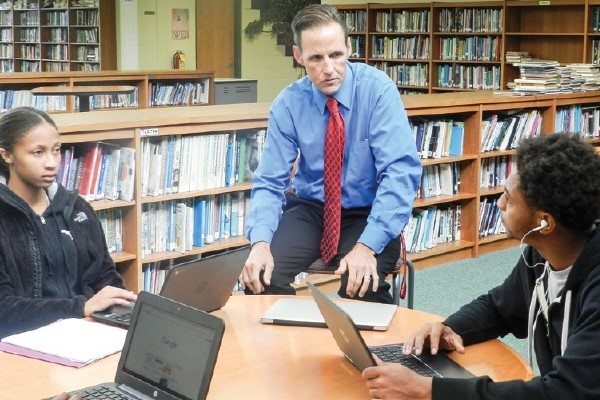Persuading the Staff
December 01, 2016
How did the administrator of perhaps the world’s first ‘flipped’ school get teachers to adopt a totally new approach to instruction?

In 2010, my spirits and those of my staff were sinking. Our failure rates for 9th graders were 52 percent in English and 44 percent in math. Discipline was rapidly deteriorating. Students were frustrated. Parent complaints had skyrocketed. Something was obviously wrong.
As principal of a high school of 500 students in Clintondale, Mich., located just north of Detroit, I was personally determined to fix the real and perceived problems. We were desperate for answers and willing to listen to anyone with a worthwhile idea to improve our state. We realized our school’s ability to be a place where students knew they could get help with problems that endangered their educational progress was faltering. As a staff, we were disturbed because we knew many students faced difficult life circumstances.
Today, Clintondale High School is recognized by CNN Money as one of the Top 41 Most Innovative Schools in America. Staff has given up deeply established practices of a classroom-lecture format and adopted a flipped classroom where students watch instructional videos at home and use class time to do homework.
Starting With Why
Changing perceptions would eventually prove an important factor that led to our success. But initially, I did not question my understanding of the way high school students learn best in school. Why would I?
Our high school classrooms looked like other classrooms: We spoonfed information to students during class and they went off and developed their own understanding with it. The lecture format is how all schools routines are built. This setup had worked acceptably for years.
I started with the typical responses: “We all need to work harder, align our curriculum again, create new assessments, etc.” But after six months, we were experiencing the same outcomes.
Change of Events
An event that provided fresh insight came during my annual senior student lunch, when I invited 10 students to share their personal reflections on the best aspects of their high school experience. Conversations focused on what they really liked about their school and what was most helpful to them.
Students opened up. They explained they had a hard time with homework because they felt they had no support at home. When they did it with their teacher present, they felt so much more confident. They also said they were frustrated that teachers did not incorporate technology into instruction, and they believed YouTube and Google were tools that could help them learn.
Could these be answers to our academic challenge? The possible solution did not come from an expert or a fancy in-service program leader. Instead, it came from students, who were reshaping the question rather than reciting what was wrong with school.
In the following weeks, I dug for answers on how students and teachers felt about homework. A survey revealed 80 percent of students did not or could not do their homework. Many students said they needed more immediate support. Fortunately, the survey reported students and teachers indicated they worked well together.
Subsequently, the flipped classroom allowed students and teachers to work together more closely, and students were immediately successful. As a school, we developed a deeper understanding of each student and how each learned.
Tipping Point
In 2011, I anxiously asked our entire staff to examine their day-to-day teaching routines. I shared what I heard in lunch meetings with seniors. I asked them about our core mission as educators. Was it to relay information to our students or help them with their own understanding and thinking skills? How were we spending the majority of our time together
The answers began exposing our core function. We examined our use of class time and discovered 83 percent was spent talking to students and not working with them. Our mission on paper was to develop our students’ skills, yet our teaching and learning process was centered on sharing information and having them develop their processing skills at home.
It was the greatest learning in my 18-year career.
At that moment, we realized we had to change course by flipping our entire instructional process around what our students needed. We restructured our classrooms so 80 percent of the time students were practicing with their teacher and 20 percent was direct instructional time. We used YouTube and Google to share information with students prior to class and assist us with collaboration. As a result, the percentage of students failing one class dropped to under 10 percent and disciplinary cases declined a jaw-dropping 300 percent. Our graduation rate topped 90 percent in just 18 months.
By asking the right people the right questions and then aligning our processes to our core mission, we finally found the way to be successful. At the time, we found no model to follow or expert to call upon. We guided ourselves in becoming a flipped school — a place where students would be required to review lecture material at home and complete homework during class time.
This transformation of the core instructional process wasn’t without some failure — and lots of lessons learned.
Center of Attention
It’s now five years later. What we’ve done in Clintondale is nothing short of developing what we believe is the world’s first flipped school. (Others have certainly followed in the years since.) Administrators and teachers from about 400 school systems from across the U.S. and well beyond have visited our high school looking to flip their own instruction delivery systems.
I admit that not everyone who has observed our flipped delivery model enjoys the same supportive administrative situation as I do at Clintondale, where I moved into the superintendency a year ago.
As a reflective leader, I have learned more about organizational leadership and the process of change when I failed at something. The failures have allowed me to stretch my thinking and made me push myself to find solutions in ways I never would have considered before. My failures caused me to ask myself and my staff, “Why do we do what we do?” and “How could we do it differently to get a different outcome?”
Misguided Notion
How is it possible to change a school’s conversations to invoke serious change?
What I learned through my failures is how to have intentional, thoughtful, persuasive and tactful conversations with teachers to change deeply established practices and routines. The biggest mistake I committed at the outset of our flipped school project was how I communicated with our teaching staff about our need for change.
I typically spoke to my union-based teaching staff about how our students need us to change. It was the same conversation I’d had a thousand times. The exhausted eye rolls were a common reaction.
One evening, feeling beaten down and frustrated, I vented to friend, a savvy retired salesperson. He offered this seemingly simple advice: When selling a new idea, product or service to someone, your conversation must be about how it will make their own situation better rather than someone else’s. If you are asking staff members to change their practice, how will it be better for them? How do you improve their lives, relieve their frustrations?
I knew our staff was extremely frustrated with students not completing homework, so I asked myself how flipped routines provided relief to teachers. The answer: By flipping teaching routines, teachers could have more control of their student’s learning cycle and even their classroom’s destiny.
Telling them how it would make their job easier, less complicated and less frustrating was the starting point to the changes we needed. Teachers began to transform themselves. Instead of looking at this project as the next top-down reform they had to follow, they saw it as a solution to their own professional challenges and encouraged peers to dive in.
A Shining Path
I learned from my communication failures of not asking the right questions and not tailoring my conversations around a personalized solution for our staff. Our ultimate lesson was that from failure, one can find a path to be someone who leads the way.
Greg Green is superintendent of the Clintondale Community Schools in Clintondale Township, Mich.
E-mail: greeng@clintondaleschools.net.
Twitter: @flippedschool
Advertisement
Advertisement
Advertisement
Advertisement


